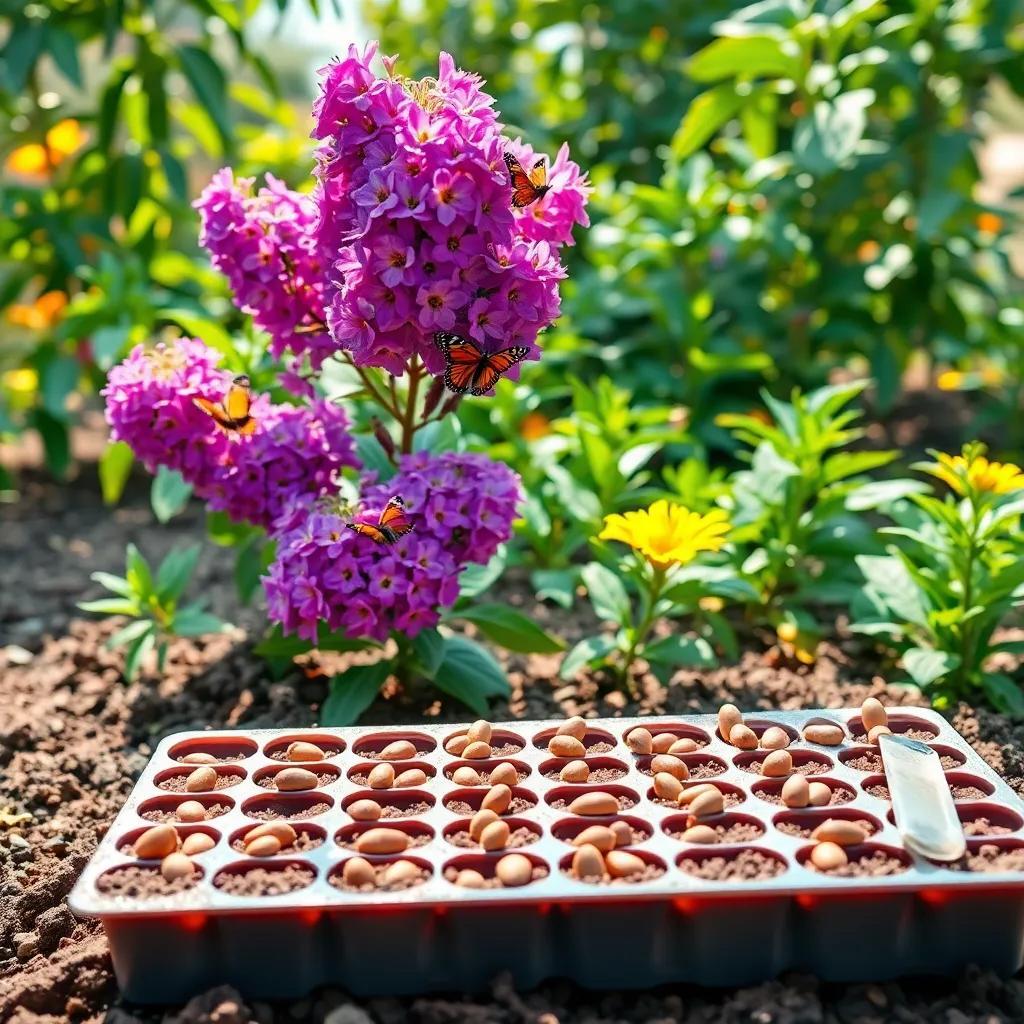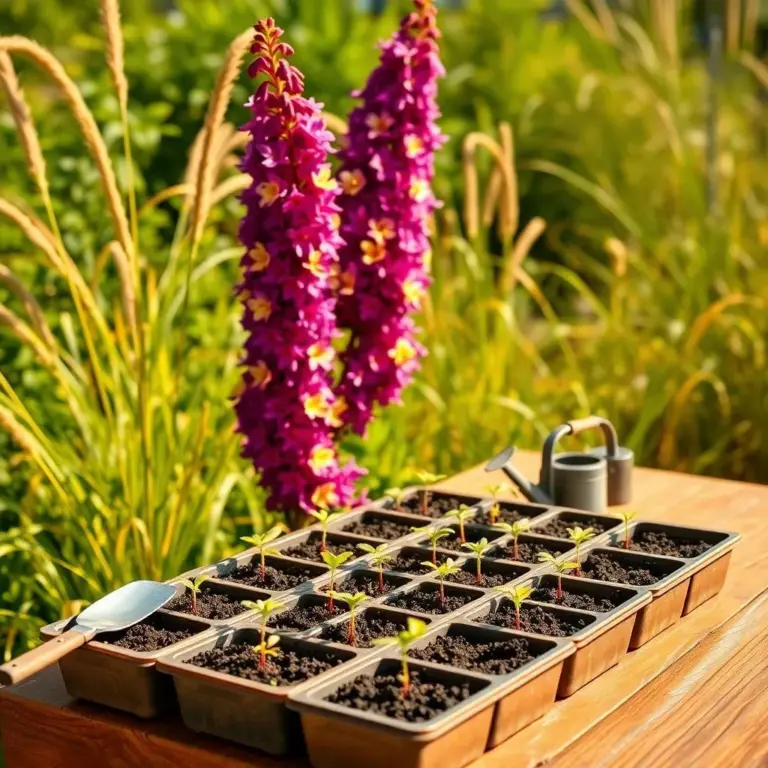Are you ready to make your garden a butterfly paradise? Growing butterfly bushes from seeds is not only fun, but it’s also a fantastic way to attract beautiful butterflies and pollinators to your outdoor space! In this guide, I’ll share everything you need to know, from understanding this lovely plant to caring for your seedlings and keeping them healthy. Let’s get started on creating a blooming haven together!
Understanding the Butterfly Bush Plant’s Characteristics
The butterfly bush, with its gorgeous flowers and delightful fragrance, is truly a gem in any garden! Officially known as Buddleia, this plant is not just pretty—it’s a magnet for butterflies and other pollinators! Who wouldn’t want to invite these little winged friends into their garden?
Here are some fun facts about this fantastic plant:
- Native Origins: Originally from China and parts of Asia, the butterfly bush has made its way around the globe. It’s like the popular kid in the plant world, showing up at gardens everywhere!
- Vibrant Colors: It’s not just about being beautiful; the flowers come in various shades, including purple, pink, white, and yellow! Imagine a rainbow in your backyard!
- Pollinator Paradise: One of the best things about butterfly bushes is that they provide nectar for butterflies, bees, and hummingbirds. Talk about a backyard party for our fluttery friends!
- Sun and Soil: While this plant loves full sunlight, it can tolerate partial shade. It prefers well-draining soil, which makes it a bit easy-going. Just remember, no soggy roots!
Be mindful that in some places, butterfly bushes can be considered invasive. It’s like they want to party too hard! To keep things in check, consider planting sterile varieties that won’t produce seeds. This way, you can enjoy all the beauty without any worry!
Getting to know more about the butterfly bush is exciting! It’s important to understand its needs for sunlight, soil, and space in your garden. With the right care, you’ll have a flourishing plant that brings joy and color to your outdoor space!
Preparing for Seed Germination: Essential Steps
Now that you’re pumped about butterfly bushes, it’s time to talk about how to get those seeds to sprout! Growing butterfly bushes from seeds is like magic, and I’m here to help you with the process. Let’s get started!
What You’ll Need:
- Seeds: Fresh butterfly bush seeds are a must! Check your local garden center or online.
- Containers: You can use seed trays or small pots. Just make sure they have drainage holes!
- Seed-Starting Mix: This is special soil that helps seeds germinate better. Regular soil might be too dense, and we want our seeds to breathe!
- Water: Keep that soil moist but not like a swamp. We want happy seeds!
Steps for Germination:
- Scarification: This fancy word means gently nicking or scratching the seed coat. It helps water get in and says, “Hey seed, it’s time to grow!” You can use sandpaper or a small knife. Just be careful not to hurt your fingers!
- Planting: Fill your containers with the seed-starting mix, then moisten it. Place your seeds on top and gently press them in, but don’t bury them deep—they need some light!
- Cover Up: Sprinkle a thin layer of soil over the seeds. Mist the top to keep it damp.
- Create a Cozy Environment: Cover your containers with plastic wrap or a dome to keep the moisture in. Place them in a warm spot with plenty of light, avoiding direct scorching sunshine!
- Patience is Key: Keep checking the moisture level and mist if needed. In about 10 to 30 days, you should see tiny seedlings popping up, and trust me, that’s a moment worth celebrating!
Getting your seeds ready to grow is a thrilling step! Each tiny seed holds the promise of vibrant flowers and fluttering butterflies. So, roll up your sleeves and prepare for some planting fun!

Care Tips for Successful Butterfly Bush Seedlings
Once your butterfly bush seeds have sprouted into adorable little seedlings, the fun really begins! Caring for these young plants is like nurturing a tiny garden army ready to take on the world. Here are some handy tips to help your seedlings grow strong and healthy!
Watering
Keeping the soil just right is key! Make sure to keep it evenly moist, but not soaked. It’s a balancing act! Check the soil daily. If the top inch feels dry, it’s time to water! I like to water at the base of the plant, so the leaves stay dry. Wet leaves can lead to pesky diseases. Yikes!
Feeding
While butterfly bushes aren’t super needy, they will appreciate a little boost. I recommend using a balanced, slow-release fertilizer during the growing season. Just a sprinkle in the spring and maybe again in mid-summer will do the trick! Follow the instructions on the package for the right amount.
Pest Protection
Keep an eye out for little intruders! Common garden pests like aphids and caterpillars can sneak up on your seedlings. If you spot any, don’t panic! You can use insecticidal soap or neem oil to get rid of them. Or, let nature lend a hand by introducing beneficial insects like ladybugs. They love to munch on those bad guys!
Monitoring for Diseases
Butterfly bushes are generally tough, but they can occasionally get fungal issues like powdery mildew. Keeping the plants spaced out ensures good air circulation. If you see any signs of trouble, check with your local garden center for recommendations on safe fungicides.
With a little TLC, your seedlings will thrive! Soon enough, you’ll have healthy plants that will brighten up your garden and attract honeybees and butterflies like nobody’s business!
Transplanting Your Butterfly Bush Seedlings
Once your butterfly bush seedlings have grown strong and tall (around 2-3 inches, and with a few sets of leaves!), it’s time for the big move—transplanting! This is an exciting moment, like sending your kids off to their first day of school. Here’s how to do it:
Timing
Plan to transplant your seedlings in early spring after the last frost or in early fall. Picking the right time gives your seedlings the best chance to settle in before facing extreme weather!
Preparing the Planting Hole
Grab a spade and dig a hole that’s a bit bigger than the root ball of your seedling. You want to give those roots plenty of room to spread! Loosen the soil around the hole, too; it helps them grow better.
The Transplanting Process
- Remove the Seedling: Carefully take your seedling out of its container. You can gently squeeze the sides to loosen it up. Just be sure to keep the root ball intact!
- Positioning: Place the seedling in the hole, making sure it’s at the same depth as it was in its pot. A little above ground is fine, but don’t bury it too deep!
- Backfill and Water: Fill the hole with soil, gently pressing it around the roots to eliminate air pockets. Then, give it a good drink of water to help settle the soil around it!
Ongoing Care
After transplanting, keep watering regularly, especially during dry spells. Adding a layer of organic mulch around the plant will help retain moisture and keep weeds at bay. Monitor your seedlings after transplanting to make sure they’re happy in their new home!
Follow these steps, and before you know it, your butterfly bush seedlings will take off, bringing joy and beauty to your garden!
Pruning and Maintaining Healthy Butterfly Bush Plants
After your butterfly bushes have settled in and started to grow, it’s time to think about keeping them in shape with some good old-fashioned pruning and maintenance. Pruning is like giving your plant a nice haircut—it helps them look their best while promoting healthy growth!
When to Prune
The best time to prune butterfly bushes is in late winter or early spring, before the new growth starts. Timing is everything! Pruning during this period helps your bush focus its energy on growing fresh stems and blooms.
What to Prune
- Dead or Damaged Branches: Take your clean, sharp pruning shears and remove any dead or broken branches. Cut them back to healthy growth points or right at the base.
- Encouraging Bushy Growth: Trim back the remaining stems to about one-third of their height. Look for those healthy buds to cut just above—they’ll help create new growth and flowers!
- Remove Spent Blooms: Throughout the season, don’t forget to deadhead your butterfly bush by snipping off faded flowers. This encourages new blooms and extends the flowering period. Talk about a win-win!
Monitoring for Pests and Diseases
Keep an eye out for unwanted guests. Regularly check for pests like aphids and caterpillars, and don’t hesitate to take action if you spot any. Also, look out for signs of diseases like powdery mildew and treat them promptly.
Watering and Fertilization
Make sure your butterfly bush gets plenty of water during hot, dry spells. A little slow-release fertilizer in spring can give them a nutrient boost to keep them happy and thriving.
With a little love and care, your butterfly bush will flourish, creating a stunning display of vibrant flowers while attracting butterflies and other pollinators to your garden! Happy pruning!

